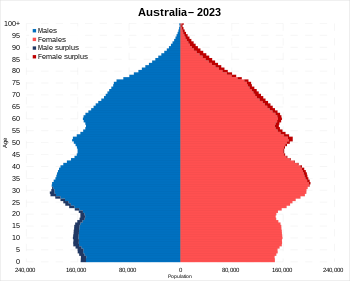
Demographics of Australia
From Wikipedia, the free encyclopedia
The population of Australia is estimated to be 27,155,800 as of 23 April 2024.[1] Australia is the 56th[2] most populous country in the world and the most populous Oceanian country. Its population is concentrated mainly in urban areas, particularly on the Eastern, South Eastern and Southern seaboards, and is expected to exceed 30 million by 2029.[3]
| Demographics of Australia | |
|---|---|
 Population pyramid of Australia in 2022 | |
| Population | 26,997,958 (as of January 2024) |
| Growth rate | 1.60% (2023 est.) |
| Birth rate | 12.3 births/1,000 population |
| Death rate | 6.77 deaths/1,000 population |
| Life expectancy | 83.09 years |
| • male | 80.93 years |
| • female | 85.36 years |
| Fertility rate | 1.63 children |
| Infant mortality rate | 3.01 deaths/1,000 live births |
| Net migration rate | 6.93 migrant(s)/1,000 population |
| Sex ratio | |
| Total | 0.99 male(s)/female (2022 est.) |
| At birth | 1.05 male(s)/female |
| Nationality | |
| Nationality | Australian |
| Major ethnic | Irish English Scottish Chinese Italians Germans Aboriginal Australians Arabs[N 1] Greeks Dutch Vietnamese various others |
Australia's population has grown from an estimated population of between 300,000 and 2,400,000 Indigenous Australians at the time of British colonisation in 1788 due to numerous waves of immigration during the period since. Also due to immigration, the European component's share of the population rose sharply in the late 18th and 19th centuries, but is now declining as a percentage.[4]
Australia has an average population density of 3.5 persons per square kilometre of total land area, which makes it one of the most sparsely populated countries in the world. This is generally attributed to the semi-arid and desert geography of much of the interior of the country. Another factor is urbanisation, with 89% of its population living in a handful of urban areas, Australia is one of the world's most urbanised countries.[5] The life expectancy of Australia in 2015–2017 was 83.2 years, among the highest in the world.[6]